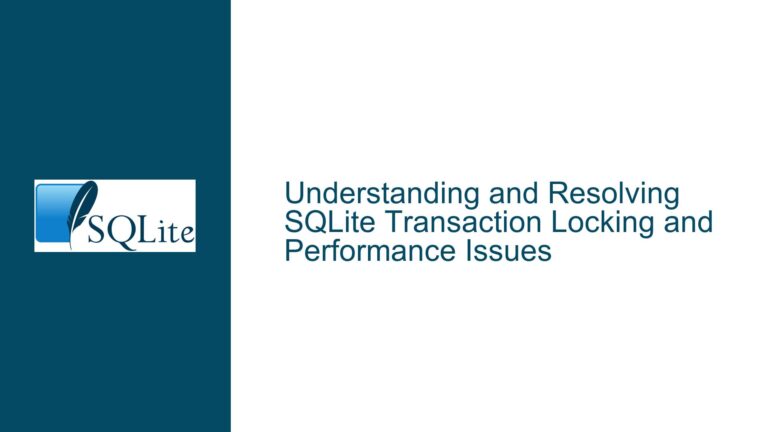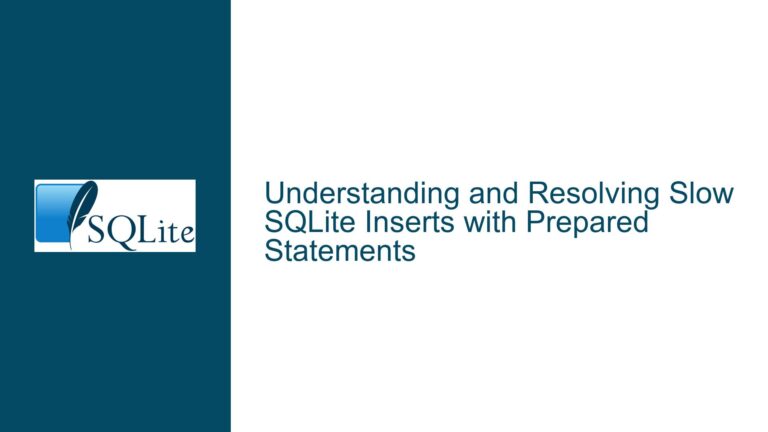Optimizing SQLite Query Execution with Virtual Tables and xBestIndex
Understanding Query Optimization in SQLite Virtual Tables
When working with SQLite virtual tables, understanding how query optimization occurs is crucial for achieving efficient query execution. Virtual tables are a powerful feature in SQLite that allow developers to define custom storage and retrieval mechanisms. However, the efficiency of queries executed on virtual tables heavily depends on how well the virtual table implementation interacts with SQLite’s query planner.
In a typical scenario, SQLite’s query planner evaluates the SQL query and generates an execution plan that minimizes the cost of retrieving the required data. This cost is estimated based on factors such as the number of rows to be scanned, the presence of indexes, and the complexity of the query. When dealing with virtual tables, the query planner relies on the xBestIndex method to gather information about the constraints and orderings that can be applied to the virtual table. The xBestIndex method is called multiple times during the planning phase, allowing the virtual table implementation to provide SQLite with the necessary information to make informed decisions about the query plan.
The xBestIndex method is particularly important because it allows the virtual table to inform SQLite about the constraints that can be applied to the query. For example, if a query includes conditions like col3 = 100 and col4 = 200, the virtual table can use xBestIndex to indicate that these constraints can be used to filter the rows. Additionally, the virtual table can provide an estimate of the number of rows that will match these constraints, which helps SQLite in choosing the most efficient query plan.
Once the query plan is finalized, SQLite calls the xFilter method with the selected index number and index string, along with the comparison values. The xFilter method is responsible for applying the constraints and generating a "short list" of matching records. SQLite then steps through these records by calling the xNext method, which retrieves the next row from the virtual table.
In summary, the interaction between SQLite’s query planner and the virtual table’s xBestIndex and xFilter methods is key to optimizing query execution. By providing accurate information about constraints and row estimates, the virtual table can guide SQLite in generating an efficient query plan. This, in turn, allows the virtual table to focus on retrieving the smallest number of rows in the fastest possible way.
Challenges in Implementing Efficient Query Plans for Virtual Tables
Implementing efficient query plans for virtual tables in SQLite presents several challenges, particularly when dealing with complex queries that involve multiple constraints and groupings. One of the primary challenges is ensuring that the virtual table’s xBestIndex method provides accurate and useful information to SQLite’s query planner. If the information provided by xBestIndex is inaccurate or incomplete, SQLite may generate a suboptimal query plan, leading to inefficient query execution.
Another challenge is handling the interaction between the virtual table and SQLite’s query planner when dealing with grouped queries. For example, consider a query that involves a GROUP BY clause, such as SELECT SUM(col1), col2 FROM Table WHERE col3 = 100 AND col4 = 200 GROUP BY col2. In this case, the virtual table must not only apply the constraints on col3 and col4 but also ensure that the rows are grouped correctly by col2. This requires careful coordination between the xBestIndex and xFilter methods to ensure that the grouped rows are retrieved efficiently.
Additionally, the virtual table must handle the ordering of rows when dealing with grouped queries. SQLite may request that the rows be ordered by the grouping column (e.g., col2) to facilitate the grouping operation. The virtual table must be able to provide this ordering information to SQLite, either by sorting the rows internally or by indicating that the rows are already ordered.
Furthermore, the virtual table must be able to handle the case where SQLite decides to perform a full table scan. In this scenario, the virtual table’s xBestIndex method will be called without any usable constraints, and the virtual table must return an estimate of the total number of rows in the table. This estimate is used by SQLite to determine the cost of a full table scan and to compare it with other potential query plans.
Finally, the virtual table must be able to encode the information provided by xBestIndex in a way that can be understood by the xFilter method. This includes encoding the constraints, their order in the argument list, and any guarantees about the constraints (e.g., whether the virtual table can guarantee that the constraints will always be satisfied). This encoding must be consistent and reliable to ensure that the xFilter method can correctly apply the constraints and retrieve the matching rows.
In summary, implementing efficient query plans for virtual tables in SQLite requires careful handling of constraints, groupings, orderings, and full table scans. The virtual table must provide accurate information to SQLite’s query planner and ensure that the xFilter method can correctly apply the constraints and retrieve the matching rows. This requires a deep understanding of SQLite’s query planning process and the ability to coordinate between the xBestIndex and xFilter methods.
Leveraging xBestIndex and xFilter for Optimal Query Execution
To achieve optimal query execution in SQLite virtual tables, it is essential to leverage the xBestIndex and xFilter methods effectively. These methods play a critical role in guiding SQLite’s query planner and ensuring that the virtual table can retrieve the required rows efficiently.
The xBestIndex method is called by SQLite during the query planning phase to gather information about the constraints and orderings that can be applied to the virtual table. The virtual table must implement this method to provide SQLite with accurate information about the constraints, their order, and any guarantees about the constraints. Additionally, the virtual table must provide an estimate of the number of rows that will match the constraints, which helps SQLite in choosing the most efficient query plan.
For example, consider a query that includes conditions like col3 = 100 and col4 = 200. The virtual table’s xBestIndex method should indicate that these constraints can be used to filter the rows and provide an estimate of the number of rows that will match both constraints. If there are 10 discrete values for each column, the virtual table might estimate that the number of matching rows will be approximately 1/100th of the total number of rows in the table.
Once the query plan is finalized, SQLite calls the xFilter method with the selected index number and index string, along with the comparison values. The xFilter method is responsible for applying the constraints and generating a "short list" of matching records. The virtual table must implement this method to apply the constraints and retrieve the matching rows efficiently.
For example, in the case of the query SELECT SUM(col1), col2 FROM Table WHERE col3 = 100 AND col4 = 200 GROUP BY col2, the virtual table’s xFilter method should apply the constraints on col3 and col4 and retrieve the rows that match both constraints. The virtual table must also ensure that the rows are grouped correctly by col2, either by sorting the rows internally or by indicating that the rows are already ordered.
In addition to handling constraints and groupings, the virtual table must also handle the case where SQLite decides to perform a full table scan. In this scenario, the virtual table’s xBestIndex method will be called without any usable constraints, and the virtual table must return an estimate of the total number of rows in the table. This estimate is used by SQLite to determine the cost of a full table scan and to compare it with other potential query plans.
Finally, the virtual table must be able to encode the information provided by xBestIndex in a way that can be understood by the xFilter method. This includes encoding the constraints, their order in the argument list, and any guarantees about the constraints. This encoding must be consistent and reliable to ensure that the xFilter method can correctly apply the constraints and retrieve the matching rows.
In summary, leveraging the xBestIndex and xFilter methods effectively is key to achieving optimal query execution in SQLite virtual tables. The virtual table must provide accurate information to SQLite’s query planner and ensure that the xFilter method can correctly apply the constraints and retrieve the matching rows. This requires a deep understanding of SQLite’s query planning process and the ability to coordinate between the xBestIndex and xFilter methods. By doing so, the virtual table can guide SQLite in generating an efficient query plan and ensure that the query is executed as efficiently as possible.






